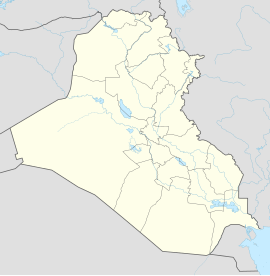Valley Afar
| Valley Afar | ||
|---|---|---|
| location | ||
|
|
||
| Coordinates | 36 ° 23 ' N , 42 ° 27' E | |
| Country |
|
|
| Governorate | Ninawa | |
| Basic data | ||
| height | 410 m | |
| Residents | 220,000 | |
| The Ottoman fort in Tal Afar | ||
Tal Afar , also Tel Afar ( Arabic تلعفر, DMG Talʿafar orتل عفر / Tall ʿAfar , Turkish Telafer ), is a city in northwest Iraq in the border region with Syria . It is located west of Mosul in the province of Ninawa and is the namesake of the Tal Afar district. The majority of the approximately 220,000 inhabitants are Turkmen . In addition to Sunnis, there are also many Shiites living in the city. Since the country was destabilized in 2003, the city has been one of the disputed areas of Northern Iraq .
The Tal Afar Citadel was founded as an Ottoman military base on a hill. The place then formed around this garrison.
geography
Tal Afar lies on a desert plain south of the Aedea Mountains. The city is about 40 km east of the Jebel Sinjar . A main road runs from west to east across the city and connects the place with Mosul.
History since 2003
The city was viewed by the US occupation forces as a center of resistance against the occupation of Iraq. They mainly blamed the Sunni minority and an infiltration of supporters from Syria. Accordingly, several offensives by US troops took place against alleged insurgents in the city.
In September 2004, some parts of the city were bombed intensively, which triggered a greater wave of refugees from the residents. The attacks were stopped after protests by the Turkish government. New fighting broke out in July and September 2005. The Baghdad government asked the residents to leave the city in order to allow US troops to march in under the command of the future security advisor Herbert Raymond McMaster . Fighting between Shiites and Sunnis flared up again in 2007, during which several hundred people died within a few days. Iraqi police officers were also involved in the killings. An attack on March 27, 2007, in which two tons of explosives were detonated in two trucks, was one of the bloodiest bomb attacks since the beginning of the war in Iraq in 2003. 152 people were killed.
On June 16, 2014, the city was captured by fighters from the Islamic State group in Iraq and the Levant . In July 2014, ISIS fighters destroyed Shiite and Sufi mosques and shrines, including the mausoleum of Ahmed Rifai , a descendant of Mohammed . The Islamic scholar Kanan Makiyah pointed out in this connection that a large part of the middle IS cadres come from Tal Afar. On October 29, 2016, Iraqi and Kurdish units began operations in the Tal Afar area in the course of the Battle of Mosul in order to cut off ISIS supply routes. After Mosul was completely under control of the Iraqi government forces again on July 9, 2017 , two larger areas, Tal Afar and al-Hawijah , remained under IS control. On August 20, 2017, the Iraqi Prime Minister announced the start of the offensive on Tal Afar and the city was taken on August 27. By the end of the month, Iraqi government troops had also captured the remaining positions held by IS fighters in the Tal Afar district. The Iraqi armed forces encountered surprisingly little resistance during the fighting in and around Tal Afar.
See also
Web links
Individual evidence
- ↑ "The fearless McMaster" in FAZ from February 21, 2017, accessed on April 12, 2017
- ↑ Wave of violence in Iraq: attack in Tal Afar was worst since the beginning of the war. In: Spiegel Online . March 31, 2007, accessed December 16, 2014 .
- ↑ See: Iraq 152 dead in attack in Tal Afar cnn.com
- ↑ Islamist rebels conquer Tal Afar. In: FAZ.net . June 15, 2014, accessed December 16, 2014 .
- ↑ Iraq: Isis boss Al-Baghdadi shows himself publicly for the first time. In: zeit.de. July 5, 2014, accessed December 16, 2014 .
- ↑ Jan-Niklas Kniewel: "Something new is happening". Conversation with Kanan Makiya. In: Jungle World , August 6, 2015.
- ↑ Focus.de: Terrorist militia kills over 230 civilians in Mosul
- ↑ See: H. Matzken: Internationale Rundschau - Near and Middle East . In: Österreichische Militärische Zeitschrift 6/2017, pp. 826–829, here p. 826 on Iraq.


